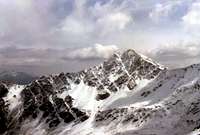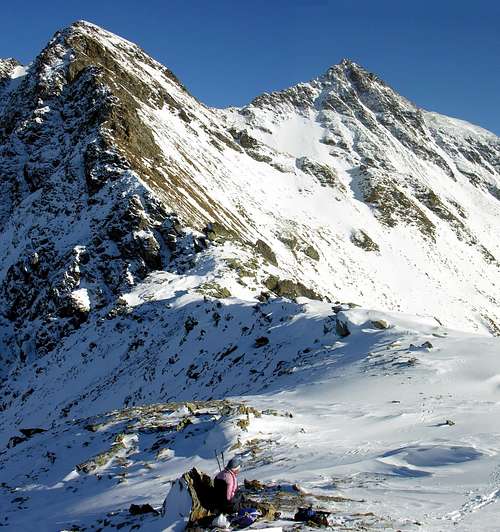-
 7149 Hits
7149 Hits
-
 87.31% Score
87.31% Score
-
 24 Votes
24 Votes
|
|
Mountain/Rock |
|---|---|
|
|
45.77170°N / 7.17261°E |
|
|
Mountaineering |
|
|
9259 ft / 2822 m |
|
|
Overview

First Ascents
- First on the summit: Unknown.
- In winter: Unknown.
- Great Traverse Testa Cordella-Mont Flassin NW Top-Flassin's Hill-Quota 2.758/9m-Mont Flassin SE Summit-Northern Vertosan's Pass-Mont Vertosan-Fenetre Hill, with descent to Comba Flassin: Osvaldo Cardellina, Marco Cossard and Giuseppe Lamazzi; Sep 17th, 1972.
Getting There
- From Torino, Milano, etc: Motorway A5. Exit at Aosta Ovest.
- From Switzerland: through the Grand Saint Bernard Tunnel or the namesake pass.
- From France: through the Mont Blanc Tunnel or Petit Saint Bernard Pass: It is not necessary to take Motorway A5: you can drive on SS.26, in the direction of Aosta.
- Aeroporto "Corrado Gex" Saint Christophe (Aosta).
From the Aosta Ovest (Aymavilles) exit of the motorway, take state highway n° 26 Toward Courmayeur. After about 5 km, you'll reach the Village of Saint Pierre (731m). Turn right on the road for the small Village of Saint Nicolas (1.200m). Past the village, you'll reach a fork. The left branch leads to Colle di Joux (1.898m). Take instead the right branch in the direction of Vetan (1.671m). At the center of the small village turn left and proceed for about 150m on paved road.
Approaches
Da Vétan-Dessus (= di Sopra; 1.737 m), posto nell'omonima amena Conca rappresa tra i versanti Meridionali dell'Aouillette o Oilletta (2.616 m) e della Punta Leissé o Leysser (2.771 m), continuare sulla strada poderale insino al suo termine, appena oltre un albergo; proseguire verso Ovest con una strada di raccordo-sentiero n° 17 che, prima allontanandosi e poi riavvicinandosi al Torrent de Vétan, s'indirizza verso l'Alpe Chatalanez (1.857 m). Da questa continuare verso Settentrione raggiungendo in breve tempo un bivio sulla strada sterrata; lasciando sulla sinistra la ramificazione che, tramite un giro molto più largo verso Ovest e passando attraverso gli Alpeggi di Pesse Dèsot (1.975 m) e Tramail l'Or (= Alto Alpeggio, in genere non il più elevato ma di Mezzo per lo spostamento del bestiame; 2.043 m), che raggiunge comunque l'importante Alpe di Grandes Arpilles (2.133 m), arrivare a quest'ultima con la ramificazione di destra. La stessa dapprima tocca il bivio 1.909 metri e poi, lasciando a Nordest la ramificazione per l'Alpe Thoules (1.944 m), continua a Nord-nordovest raggiungendo il bivio 2.091 metri sulla strada poderale che proviene dal Tramail l'Or; volgendo più a Nordest in poco tempo si raggiunge l'Alpe di Grandes Arpilles con sorgente. Dal bivio 2.133 m, appena sopra, si abbandona sulla sinistra od Ovest il ramo indirizzato alle Alpi Pesse Damon (2.274 m) e Tsacreuse o Tsecreousa (2.398 m), ove termina questa ramificazione alle pendici della Punta Aouilletta; invece continuare con direzione opposta Est-nordest e, sorpassando alcuni torrentelli secondari, raggiungere un fontanile sul ciglio della strada a quota 2.206 metri. Qui la medesima volge completamente direzione verso Nord entrando nel piccolo e stretto Vallone di Verrogne al di sopra dell'omonimo abitato (1.595 m), sempre nel Comune di Saint Pierre. Perseverare nella stessa direzione, attraverso versanti scoscesi ricchi di flora, lungo il fianco Orientale della Punta Leissé ed, oltrepassata la quota 2.279 metri soprastante l'Alpe Verdjouan (2.101 m), raggiungere il ramo più Occidentale del Torrent de Verrogne, a quota 2.284 metri; fiancheggiarlo per breve tratto per indi guadarlo a quota 2.300 metri, ove inizia il sentiero n° 13 per il Colle di Paletta e, subito dopo, una presa dell'acqua. Procedere invece sempre sulla strada poderale che, dopo aver formato una breve ansa a quota 2.329 metri, appena sotto una serie di quattro minuscoli laghetti, si riporta a Settentrione e, lasciando sulla destra un piccolo lago, ma di dimensioni maggiori, a quota 2.377 metri, perviene subito dopo all'antica Alpe di Les Crottes (2.385 m; stalle caratteristiche con volte a forma di arco), dove termina anche la strada. Dal tornante 2.329 metri è possibile inoltre proseguire su di un sentierucolo senza numerazione, che prosegue in modo parallelo alla strada, subito sotto ad Ovest.
Route
From the Alp Les Crottes (good point of departure, if he owns the permission with authorization to proceed with auto along thedirt road "poderale") to climb with the path n°13 along a secondary branch of the Torrent de Verrogne and, fording twice the same, to climb with run, to form of sinusoid, reaching the quota 2.601 meters; immediately after the same one the path is rejoined with another not numbered that, always departing from the Alpages Les Crottes but with run mostly in East, it flanks four small underlying lakes the more main point Lac Mort (2.634m). You reaches, in bottom, so the small basin the Fenetre Pass to quota 2.610 meters in a stony ground formed by rocky blocks and deposits, where in beginning in summer it is possible to still find some small snowfield. With a brief diagonal from right toward left easily the hill is reached (2.728/9m; 0h'50 from the Alpages Les Crottes). From this to go up again, through a slender and discontinuous trace of path, the easy Crest East-northeast with run among scattered rocky deposits and fine debris-rubbles at first toward West and then more to Southwest, meeting different "ambushes" of hunting, especially in the near of the Summit (0h'20 from the hill; 2h'00/2h'15 in total from Vétan Village-Resort).
Dall'Alpe Les Crottes (ottimo punto di partenza, se si é in possesso del permesso con autorizzazione a procedere con automobile lungo la strada poderale) salire con il sentiero n°13 lungo un ramo secondario del Torrent de Verrogne e, guadando due volte lo stesso, salire, con percorso a forma di sinusoide, raggiungendo la quota 2.601 metri; subito appresso la medesima il sentiero si ricongiunge con un altro non numerato che, sempre partendo dall'Alpe Les Crottes ma con percorso maggiormente ad Oriente, fiancheggia quattro laghetti sottostanti il più importante Lac Mort (2.634 m). Si raggiunge così la piccola conca al di sotto del Col Fenetre a quota 2.610 metri in una pietraia formata da blocchi rocciosi e detriti, dove in inizio di estate è possibile trovare ancora qualche piccolo nevaio. Con un breve diagonale da destra verso sinistra, facilmente, si raggiunge il colle (2.728/9 m; 0h'50 dall'Alpe Les Crottes). Da questo risalire, tramite una esile e discontinua traccia di sentiero, la facile Cresta Est-nordest con percorso tra fini detriti rocciosi e blocchi sparsi dapprima verso Ovest e poi più verso Sudovest, incontrando diversi appostamenti di caccia, soprattutto nei pressi della Sommità (0h'20 dal colle; 2h'00/2h'15 in totale dal Villaggio Turistico di Vétan).
Campings
Remember that free camping is forbidden (except for emergency reasons, over 2.500m, from darkness until dawn).Mountain Condition
- Meteo: you can find all the needed informations at the official site of the Valle d'Aosta Region:
- Valle d'Aosta Meteo
Webcam
- WEBCAM on Aosta Valley:
- Webcam
Books and Maps
BOOKS:- "Guida dei Monti d'Italia-Alpi Pennine" (Vol.I°) di Gino Buscaini-Club Alpino Italiano/Turing Club Italiano, Luglio 1971 (in Italian).
- "80 itinerari di Escursionismo Alpinismo e Sci Alpinismo in Valle d'Aosta", di Osvaldo Cardellina, Ed. Musumeci, Giugno 1977 (in Italian); seconda Ed. Luglio 1981; terza Ed. Luglio 1984; (in French), prima Ed. Febbraio 1978; seconda Ed. Marzo 1980.
- "Diari Alpinistici" di Osvaldo Cardellina e Indice Generale accompagnato da Schedario Relazioni Ascensioni 1964-2019 (inediti).
- Kompass "Monte Bianco Valle d'Aosta Sentieri e Rifugi" Carta turistica 1:50.000.
- Ediz. Bottega D'Arte Alpina Coumayeur "Carta Turistica della Valle d'Aosta" di Alessio Nebbia 1:100.000.
- I.G.M. Istituto Geografico Militare 1:25.000.
Important Information
- REGIONE AUTONOMA VALLE D'AOSTA Ufficial Site
- FONDAZIONE MONTAGNA SICURA Villa Cameron, località Villard de la Palud n° 1 Courmayeur (AO) Tel: 39 0165 897602 - Fax: 39 0165 897647.
- A.I.NE.VA. (Associazione Interregionale Neve e Valanghe).
Useful Numbers
- Protezione Civile Valdostana località Aeroporto n° 7/A Saint Christophe (Ao) Tel. 0165-238222.
- Bollettino Valanghe Tel. 0165-776300.
- Bollettino Meteo Tel. 0165-44113.
- Unità Operativa di Soccorso Sanitario Tel. 118.





















